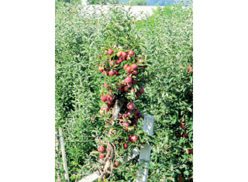
High acetaldehyde concentrations impart a bruised apple flavour to wine.
Acetaldehyde is usually associated with its negative impact on wine quality. Although it is mainly formed during alcoholic fermentation it can also occur in wine through other ways. Its formation is influenced by different factors, which need to be noted by winemakers.
Acetaldehyde, also known as ethanal, is a colourless liquid, which is often used as an intermediate product in the manufacturing of other chemicals. It is the most important aldehyde occurring in wine. At concentrations lower than 70 mg/ℓ it can impart a fruity flavour to wine, which often occur in freshly fermented wine. At higher concentrations from 100 to 120 mg/ℓ it can, however, be pungent and negative and is often associated with bruised apple, sherry, nuts and oxidation. Acetaldehyde is the most important compound, which is responsible for the binding of sulphur dioxide and this bound compound limits the negative sensory characteristics of acetaldehyde, but also limits the anti-oxidative effects of sulphur dioxide. Sulphur dioxide can also be bound by other compounds like sugars, acids and polyphenols, but not to the same extent as acetaldehyde.
During alcoholic fermentation sugars are converted to ethanol and carbon dioxide, but the process is not so simple and other by-products like acetaldehyde are also formed during the process. Acetaldehyde is, however, not only formed during alcoholic fermentation, but also as an intermediate product during the bacteriological conversion of ethanol to acetic acid by acetic acid bacteria. At low alcohol concentrations and high oxygen exposure, significant concentrations of acetic acid is formed, but at the higher alcohol concentrations of wines and limited oxygen exposure, acetic acid bacteria tend to produce more acetaldehyde. Although yeasts usually reduce acetaldehyde to ethanol, it can oxidise ethanol to acetaldehyde in oxidative circumstances, during more oxygen exposure when containers are not kept full. With certain winemaking methods, like in the case of sherry, such oxidative circumstances are promoted to favour this process. During the natural maturation of wine acetaldehyde can also be formed. This process is, however, rather of chemical than microbiological nature.
If it is accepted that high acetaldehyde concentrations in wines are disadvantageous and the sources thereof are known it should be possible to limit acetaldehyde formation. The alcoholic fermentation process consists of different stages. Sugar is initially converted to pyruvate, which is decarboxylated to acetaldehyde together with the liberation of carbon dioxide. The acetaldehyde which is formed as an intermediate product, is reduced to ethanol. During this process excessive acetaldehyde can be formed if sulphur dioxide is added during the fermentation process or the pH and fermentation temperature increase. Yeast strains also differ regarding their acetaldehyde formation. The bacteriological formation of acetaldehyde can be restricted by limiting oxidative conditions resulting from the unnecessary air exposure in containers with ullage.
Although wet chemical analysis methods exist, the gas chromatographic methods offer more accurate results. The equipment and technology required for these, limit them to advanced laboratories. Analyses which were executed at the Vintessential Labs in Australia last year showed that 68% of the wines’ acetaldehyde concentration was below 50 mg/ℓ, 18% was between 50 and 120 mg/ℓ and 13% of the wines’ concentration was higher than 120 mg/ℓ, which indicated that these wines may have oxidation problems.
If cellars do not analyse acetaldehyde routinely, free and bound sulphur dioxide concentrations must be used to monitor the possible appearance of oxidation. Many cellars tend to analyse only the free sulphur dioxide, although the bound concentration is a handy way of monitoring sulphur dioxide additions and all legal restrictions regarding the sulphur dioxide concentration of wines are based on the total (free plus bound) concentration (Byrne & Howell, 2017).
Reference
Byrne, S. & Howell, G., 2017. Acetaldehyde: How to limit its formation during fermentation. Australian Grapegrower & Winemaker, February 2017: 68 – 69.













